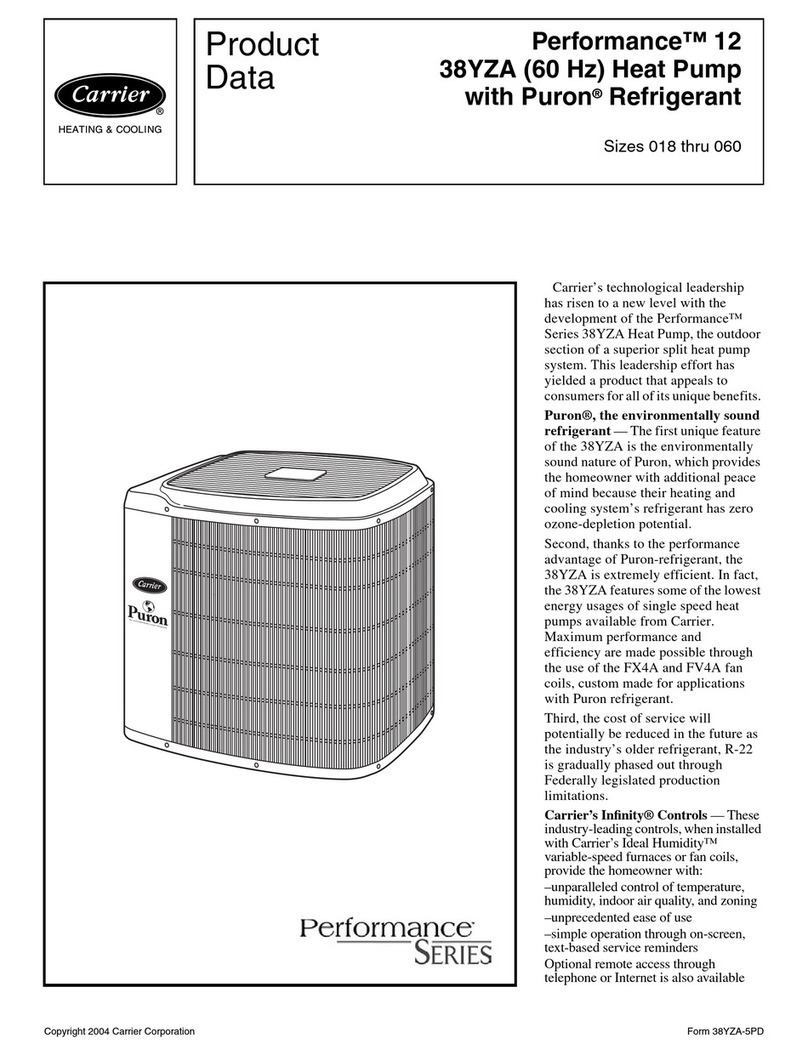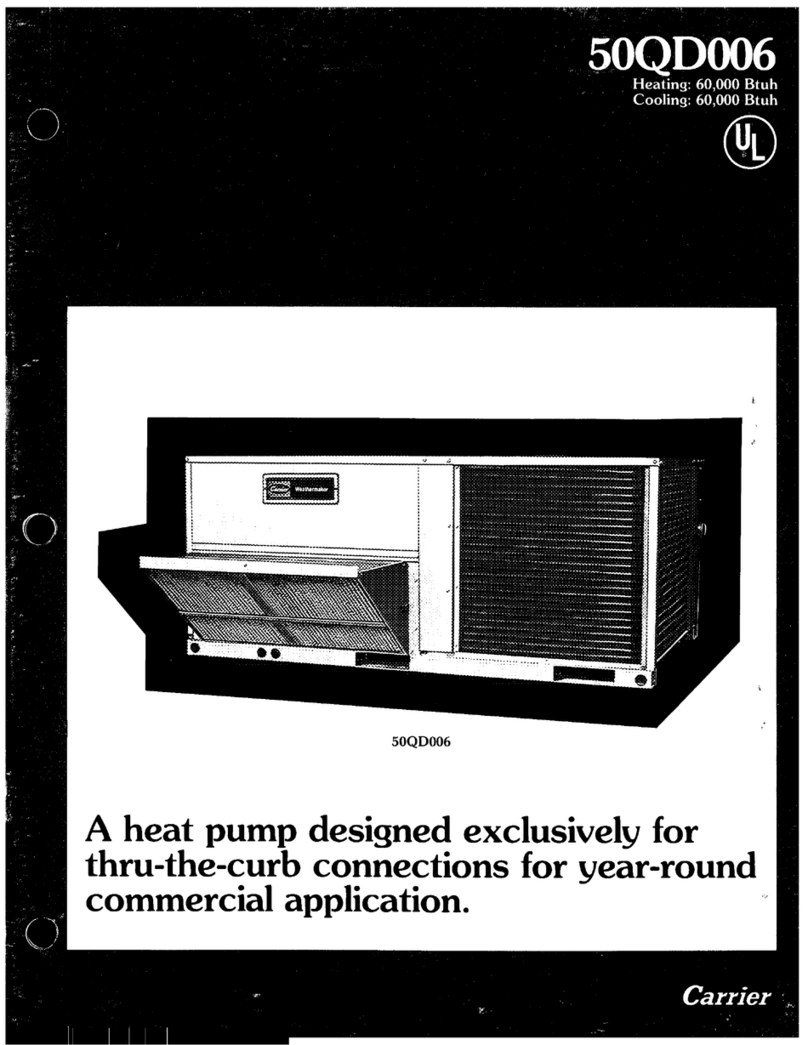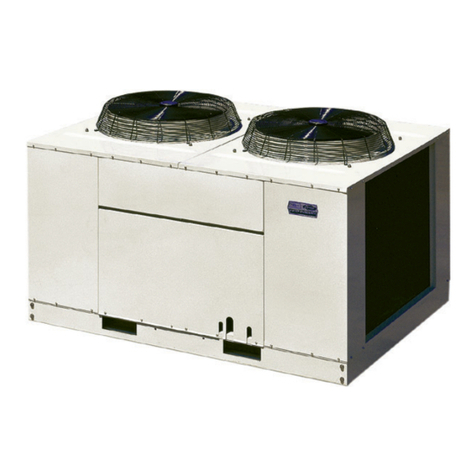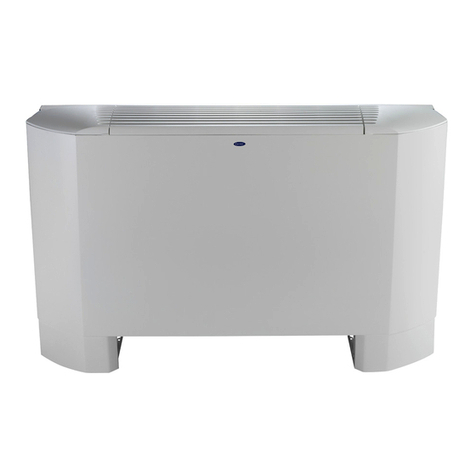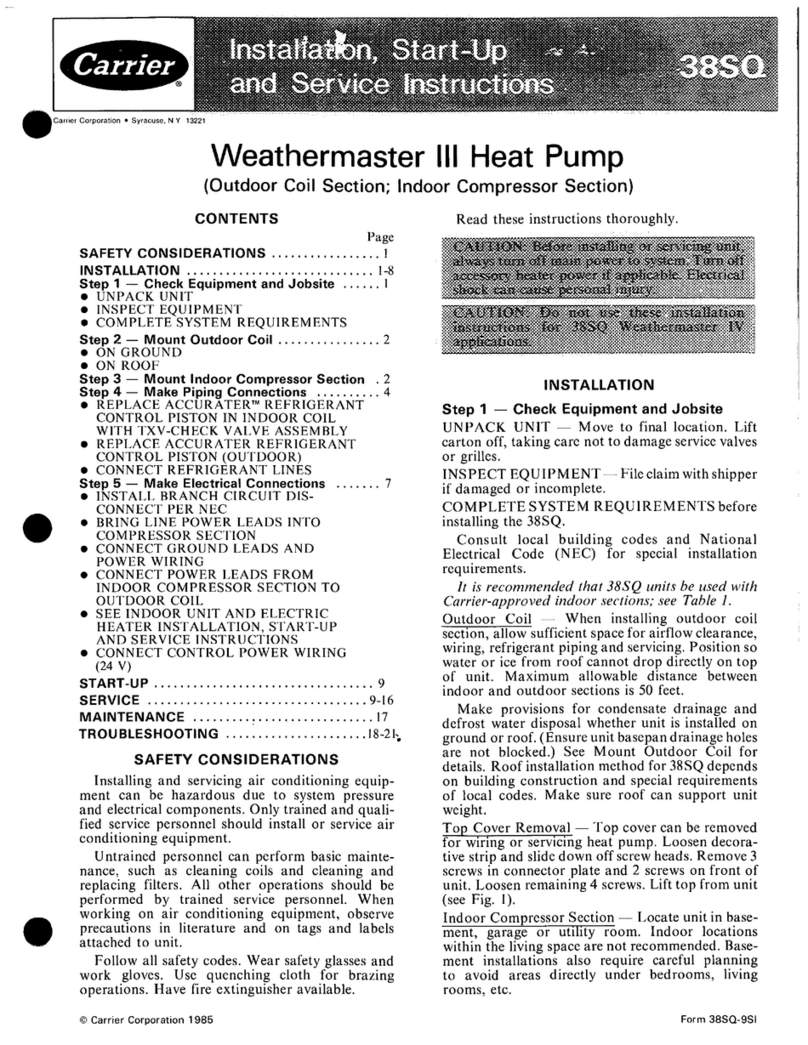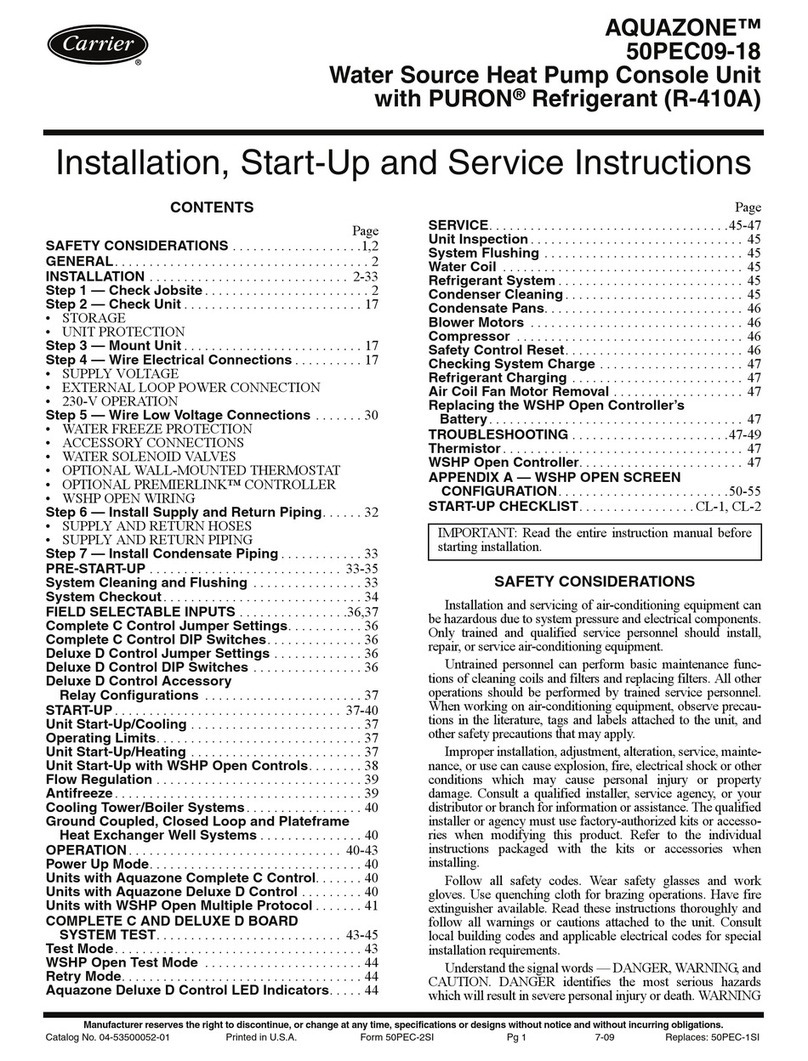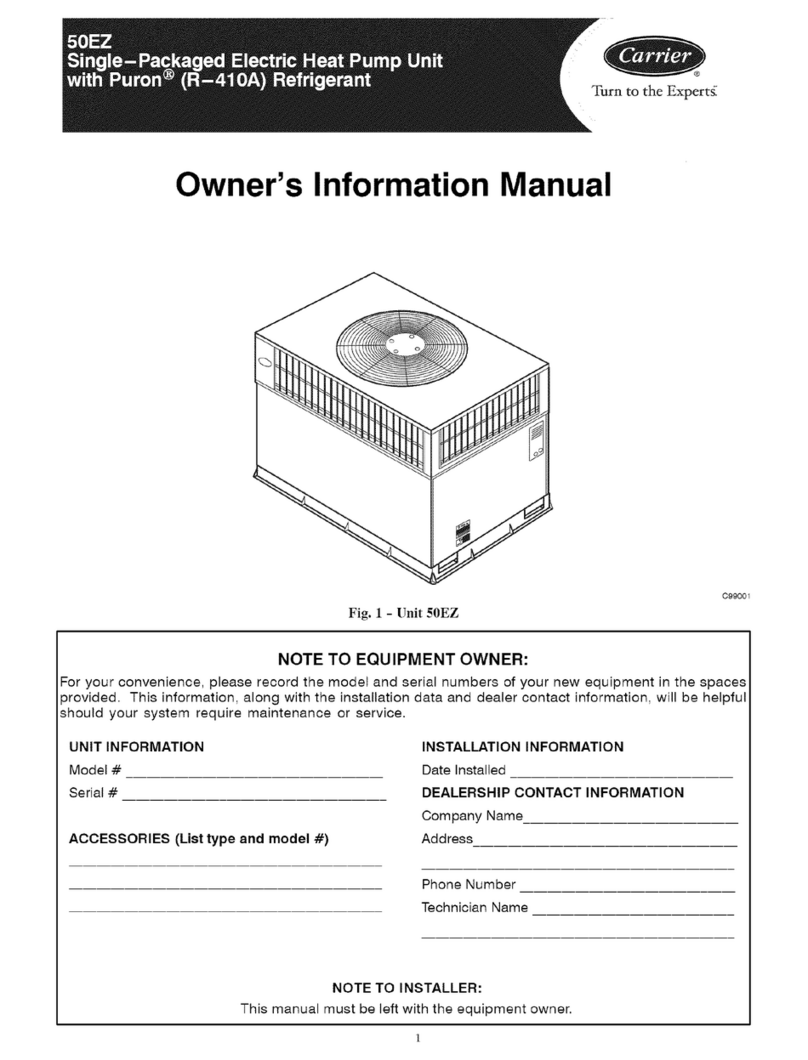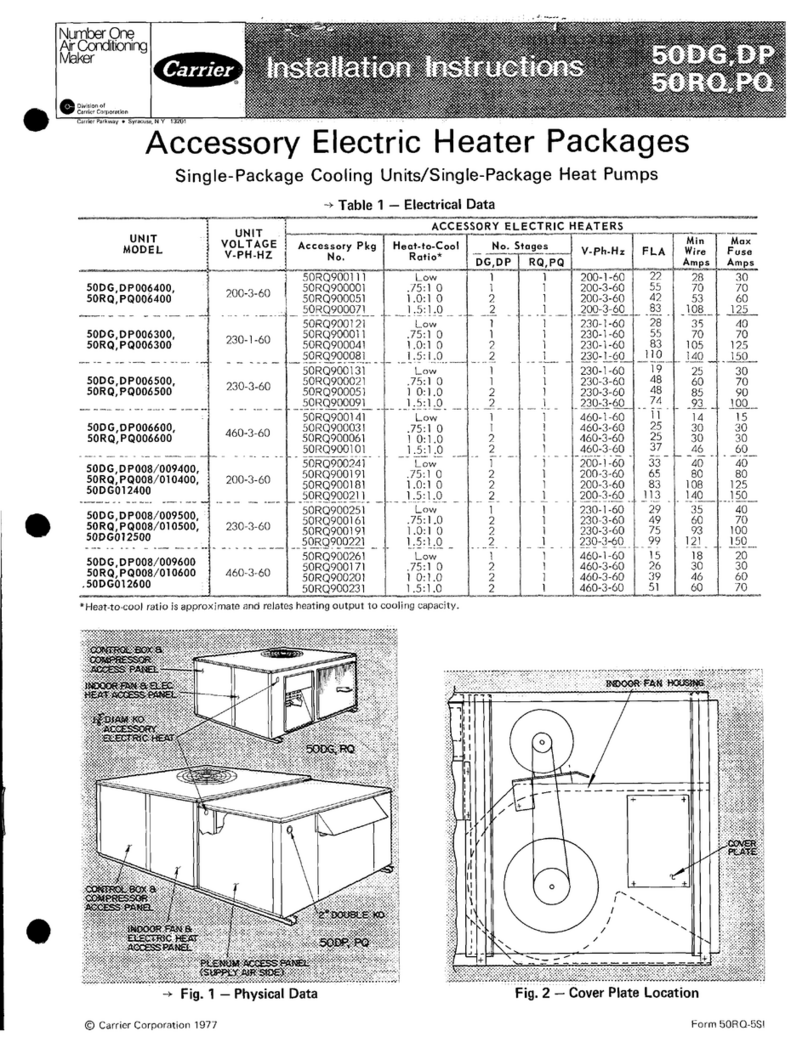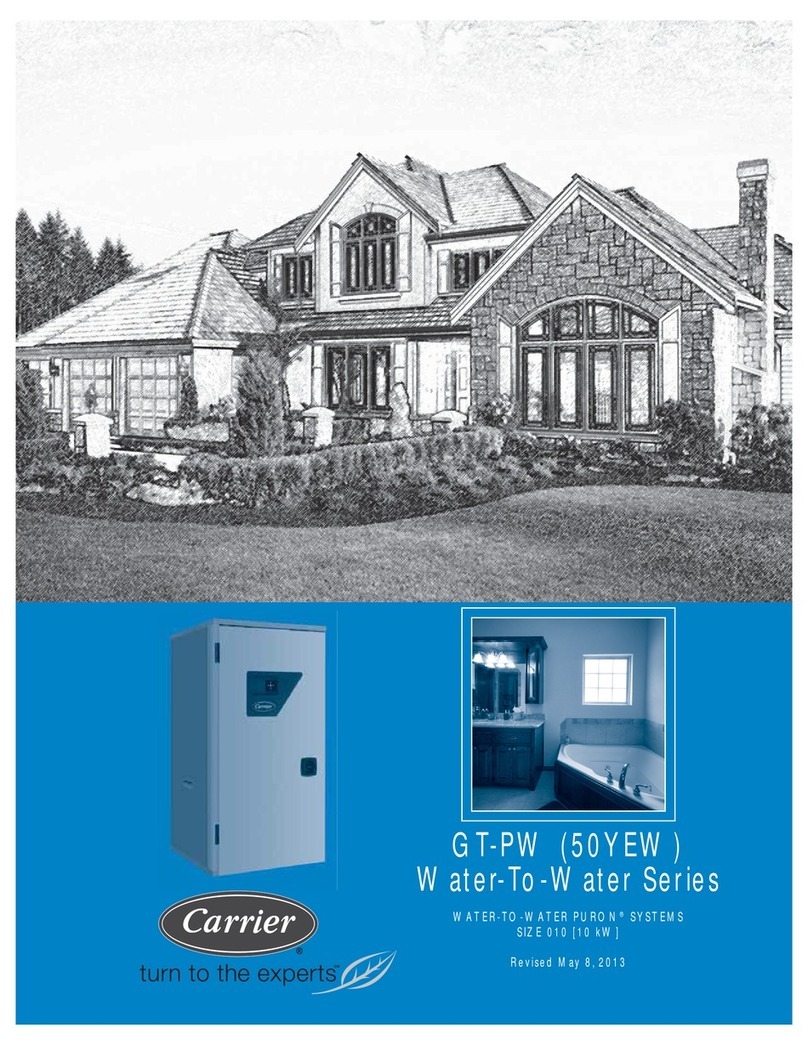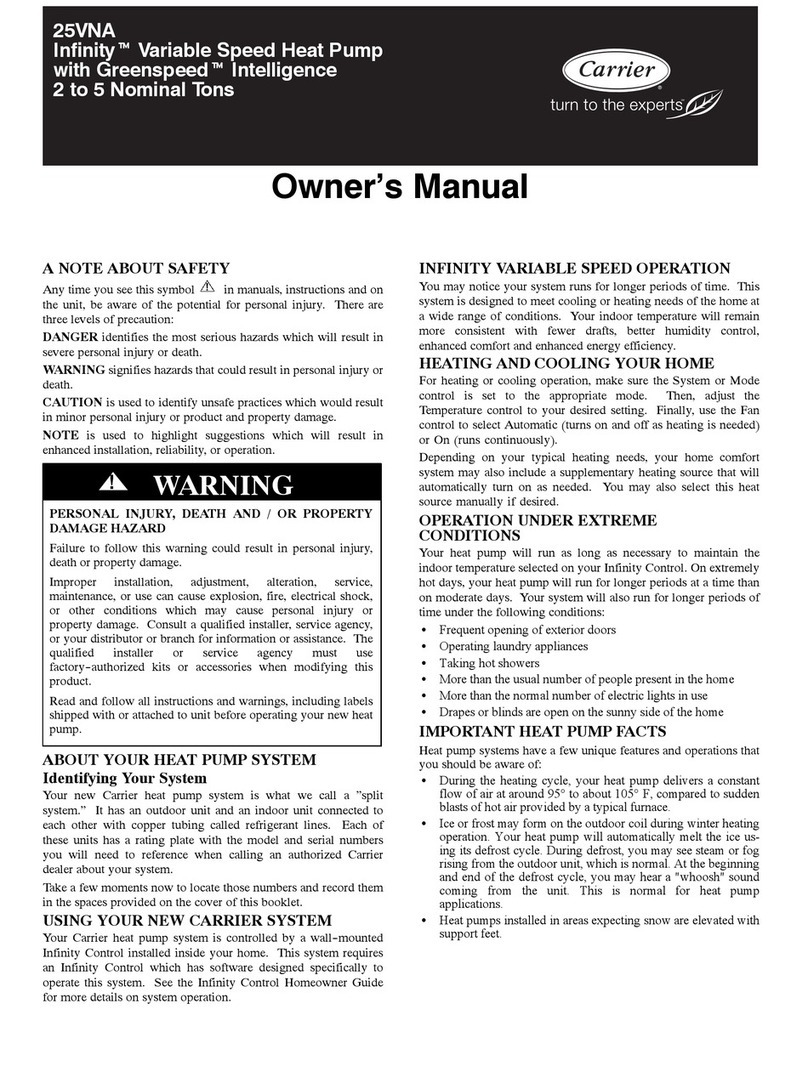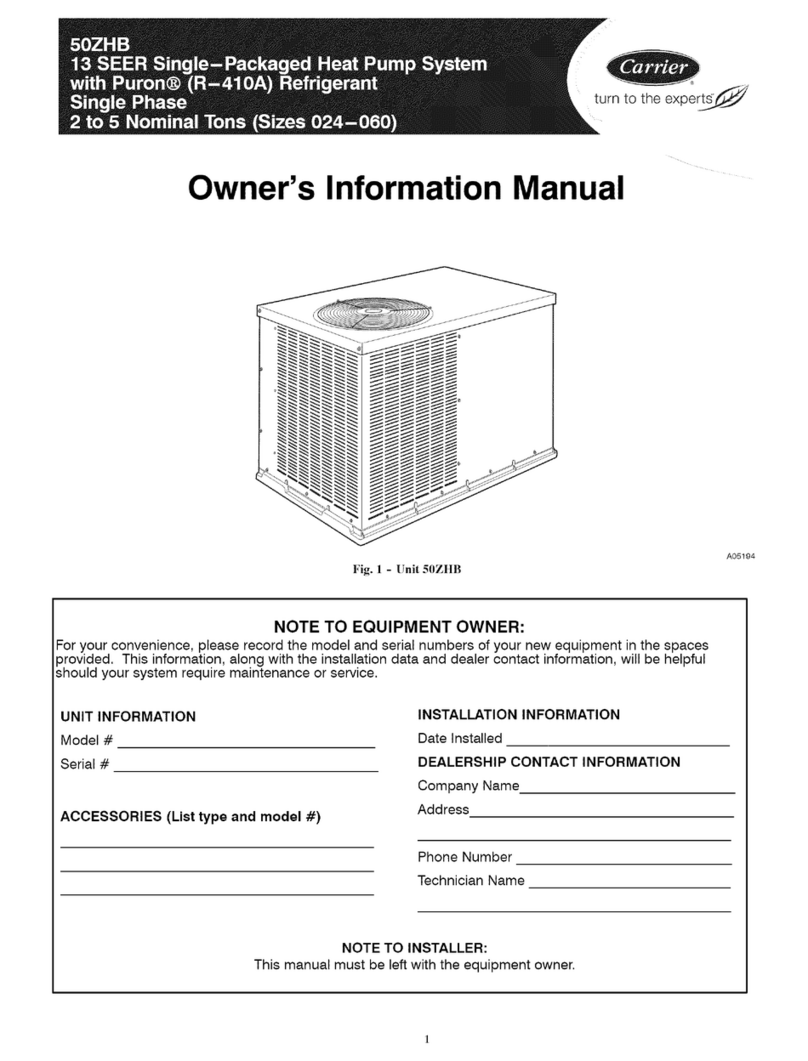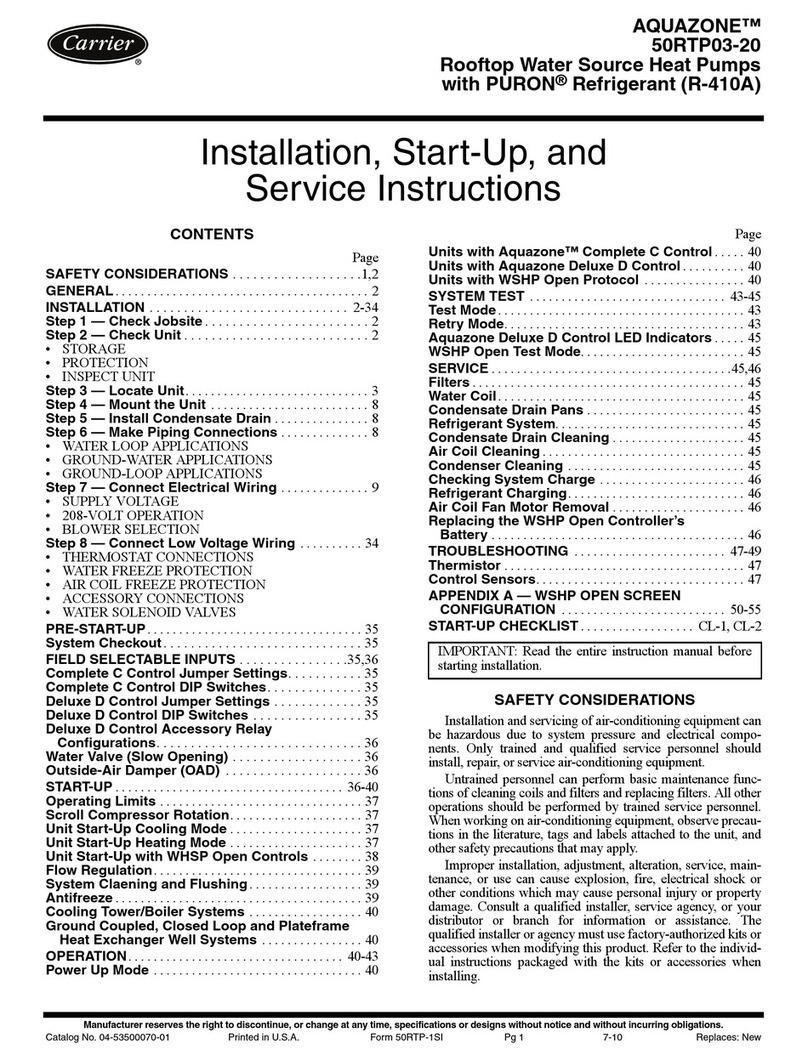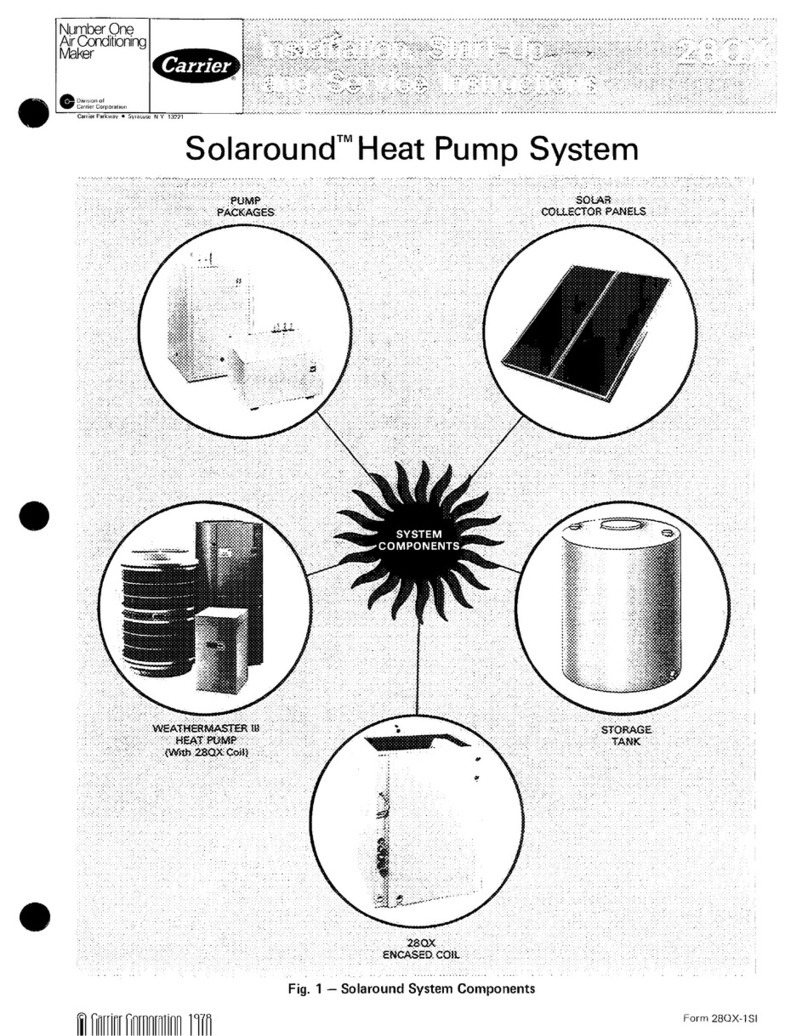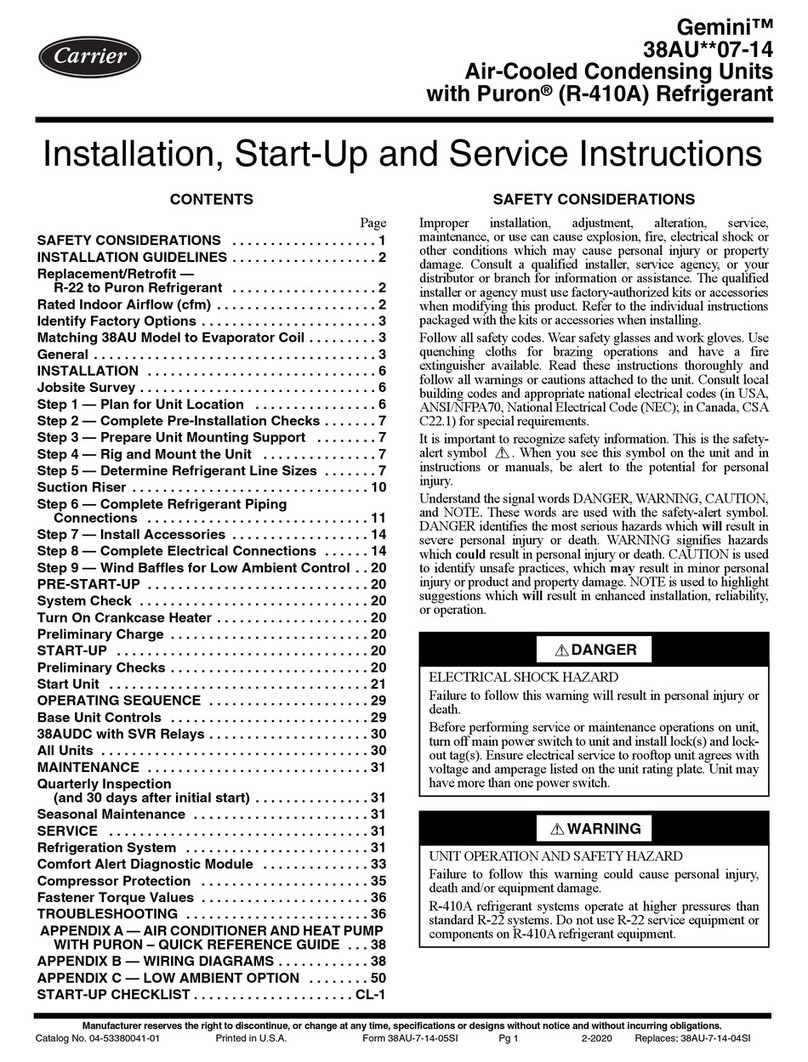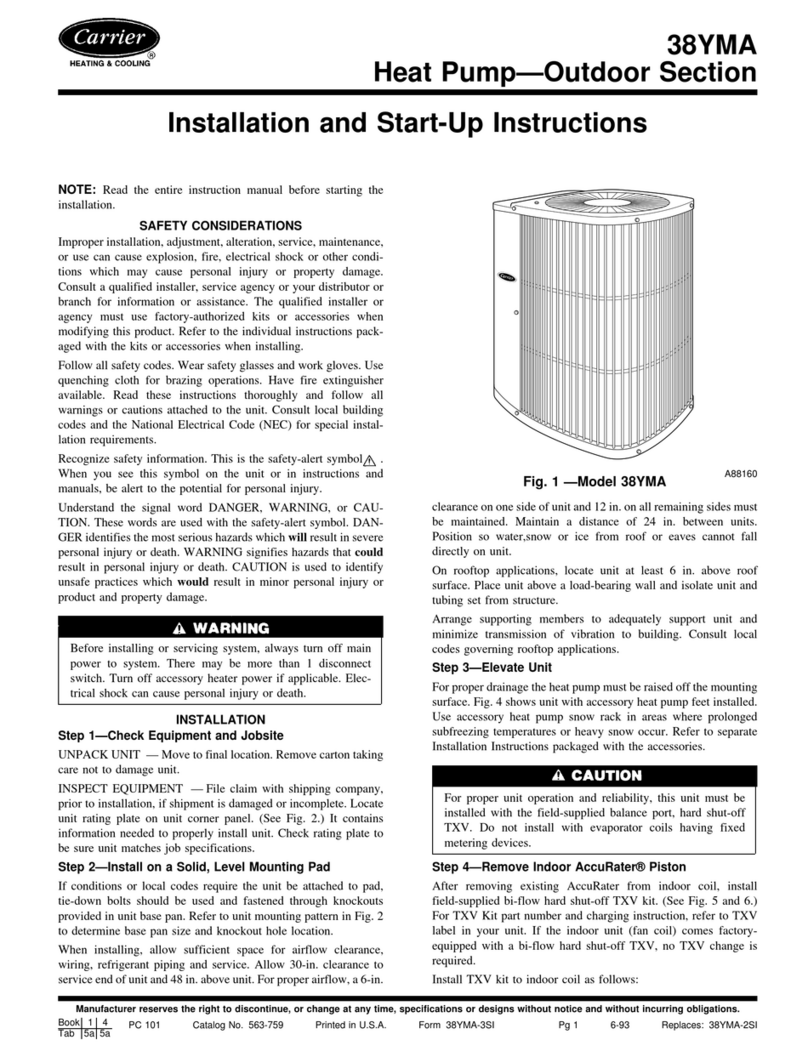
©2019 Carrier Corp.
7310 W. Morris Street • Indianapolis, IN 46231 Catalog No: OG-HPR410GEN-03
Edition Date: 08/19 Replaces: OG-HPR410GEN-02
OWNER’S MANUAL SPLIT-SYSTEM HEAT PUMP USING R-410A REFRIGERANT:
Manufacturer reserves the right to change, at any time, specifications and designs without notice and without obligations.
2
• Keep Filter Clean
A clogged or improperly installed air filter on your indoor unit will
increase operating costs and shorten the life of the unit. For detailed
filter cleaning information refer to indoor unit literature.
• Do Not Block Floor, Wall or Ceiling Vents
When drapes, furniture, toys or other common household items block
vents, the restricted airflow lessens the system’s efficiency and life span.
• Do Not Cover or Block Outdoor Unit
The outdoor unit needs unrestricted airflow. Do not cover it or place
items on or next to it. Do not allow grass clippings, leaves, or other
debris to accumulate on the sides or top of the unit. And, maintain a 12”
(305 mm) minimum clearance between the outdoor unit and tall grass,
vines, shrubs, etc.
• Check Condensate Drain
Your heat pump removes humidity from your home during the cooling
season. After a few minutes of operation, water should trickle from the
condensate drain of the indoor coil. Check this occasionally to be sure
the drain system is not clogged. Drainage will be limited if you live in a
very dry environment.
• Do Not Operate Below 55°F/13°C in Cooling Mode
Your outdoor unit is not designed to operate when outdoor temperatures
are lower than 55°F/13°C without modification. If operation below this
temperature is required, consult your authorized dealer.
• Do Not Operate Above 66°F/19°C in Heating Mode
Your outdoor unit is not designed to operate on heating mode when
outdoor temperatures are higher than 66°F/19°C. You can safely operate
the system above 66°F/19°C on emergency or auxiliary heat.
• Base Pan Drainage
Periodically check for and remove debris that has settled around the base
of your outdoor unit. This will ensure proper drainage of the base pan
and eliminate standing water inside the outdoor unit.
• Level Installation
Your authorized dealer will install the outdoor unit in a level position. If
the support base settles or shifts and the unit is no longer level, be sure to
re-level it promptly to assure proper drainage. If you notice water or ice
collecting beneath the unit, arrange for it to be drained away from the
unit.
Sea Coast Coil Maintenance
Coastal locations often require additional maintenance of the outdoor
unit due to highly corrosive airborne ocean salt. Although your new heat
pump system is made of galvanized metal and is protected by top-grade
paint, take the additional precaution of periodically washing all exposed
surfaces and the outdoor coil approximately every 3 months. Consult
your installing authorized dealer for proper cleaning intervals and
procedures for your geographic area or ask about a service contract for
regularly scheduled professional cleaning and inspections.
TROUBLESHOOTING
Before you request dealer service, check for these easily solved
problems:
• Check the indoor and outdoor disconnect switches Also check your
main electrical panel circuit breakers or fuses.
• Check for sufficient airflow. Air filter(s) should be reasonably clean
and interior vents should be open and unobstructed.
• Check thermostat settings. For cooling, your desired temperature
setting should be LOWER than the displayed room temperature, and
the System/Mode control should be on Cool or Auto. For heating,
your temperature setting should be HIGHER than the displayed room
temperature, and the System/Mode control is set to Heat or Auto.
• Time delays - depending on the heat pump you have, there may be
delays in unit operation that are built-in to protect the equipment and
your comfort. Don’t be alarmed if you notice a time delay in
operation. It may be a standard protection feature of your equipment.
Check with your authorized Dealer for more information on time
delays.
* Monthly maintenance items and outdoor unit rinsing may be performed by the consumer. All other maintenance items and all service work must be performed by a qualified service technician. Read all waring labels.
Notes:
1. The above list may not include all maintenance items. Inspection intervals may vary depending on climate and operating hours. Consult your HVAC dealer about a service contract for seasonal inspections.
2. Do not use harsh chemicals or high pressure water on coils. More frequent rinsing is required for units near a sea coast
CAUTION
!
CUT HAZARD
Failure to follow this caution may result in personal injury.
Although special care has been taken to minimize sharp edges in the
construction of your unit, be extremely careful when handling parts or
reaching into the unit.
Maintenance Checklist Recommended
Interval*
Outdoor unit specific: Monthly Annual
Clear away debris and vegetation near unit. X
Inspect cabinet for damage. Replace components that are damaged or severely rusted. X
Inspect electrical disconnect for proper function. Repair or replace as necessary. X
Inspect electrical wiring and connections. Tighten loose connections. Inspect and perform functional test of equipment as needed to ensure proper
function. Repair or replace damaged or overheated components and wiring. X
Check refrigerant system subcooling and/or superheat (system dependent). X
Inspect inside of unit. Clean if debris is present. X
Inspect condenser coil. Clean if dust, dirt, or debris is present. Rinse unit with fresh water (see Note 2). X
Inspect motor and fan for damage. Make sure fan spins freely. X
Indoor specific: (for fossil fuel furnaces and accessories, refer to unit specific literature)
Inspect, clean, or replace air filter if dirty. X
Inspect and clean blower assembly (includes blower housing, wheel, and motor). X
Inspect internal and external of cabinet. Clean as needed. X
Inspect electrical disconnect for proper function. Repair or replace as necessary. X
Inspect electrical components, wiring, and connections. Tighten loose connections. Repair or replace damaged components and wiring. X
Inspect evaporator coil. Clean if dust, dirt, or debris is present (see Note 2). X
Clean condensate pan, trap, and drain lines (more frequent maintenance may be required in humid climates - consult your local HVAC dealer). X
Inspect airflow system (ductwork). Check for leaks and repair as needed. X


